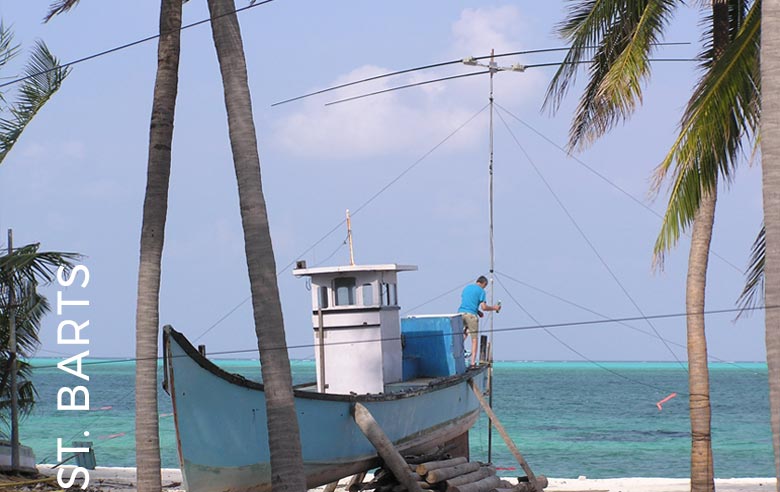

The most potent single tower antenna systems ever seen in Amateur Radio
The SteppIR Advantage
Resonant antennas must be made a specific length to operate optimally on a given frequency. Performance will deteriorate rapidly when tuning beyond the optimum frequency. Fixed length antennas, such as aluminum Yagi’s, typically “trick” the antenna into thinking it is a different length by interlacing elements, using traps or simply adding more elements that may destructively interact. The same can be said with vertical antennas which commonly employ traps or similar circuits. We solve that problem by creating an antenna that is remotely tunable using an electronic controller. SteppIR antennas enjoy optimal performance on all frequencies within their range, and that includes non-ham radio frequencies as well! Having the ability to tune the antenna to the exact length required cannot be understated – the performance improvement is profound. But don’t believe us, listen on the air for the loud signals- you will find that more often than not, those folks are using a SteppIR.
Performance
Individually Adjustable Elements
Each of the elements on a SteppIR antenna are individually adjustable in increments of 0.10 inches. This is a great feature for users that like to model antenna designs – the lengths can be implemented and saved to memory. This enables antennas to be created that focus on a higher gain, higher front-to-back or many other configurations. If the user wishes to restore the factory default settings, they can do so with a click of a button. Having an adjustable element length is also very effective in taking care of anomalies with location, height, ground quality or interaction caused by other objects.
Eliminate or Reduce Interaction
The SteppIR antenna was originally conceived to solve the problem of covering the seven ham bands (40m, 20m, 17m, 15m, 12m, 10m, and 6m) on one tower without the performance sacrifices caused by interaction between all of the required antennas. Aluminum Yagi’s are available that cover 20 meters through 10 meters by using interlaced elements, traps or log periodic techniques, but do so at the expense of significant performance reduction in gain and front to back ratios. Obviously, an antenna that is precisely adjustable in length while in the air would solve frequency problems, and in addition, would have vastly improved performance over existing fixed length Yagi antennas. The ability to tune the antenna to a specific frequency, without regard for bandwidth, results in excellent gain and front to back at every frequency. Because the antenna is tuning to the exact length required for each element, it is effectively a monobander at every single frequency, eliminating any potential for interaction. In addition, if a SteppIR antenna is near other arrays, the elements can be retracted to ensure there is no performance degradation to the other antenna. Unfortunately, we cannot do anything about a nearby antenna interacting with the SteppIR, except to make antennas that cover all the bands so you can get rid of the others!
180-Degree Reversal Mode (Yagi Antennas)
The 180-degree mode allows the user to physically change the direction of the antenna 180-degrees in approximately 2 seconds with a single click of a button. This feat is accomplished electronically with the electronic controller changing the format of the antenna elements. For example – with a 3 element Yagi, the forward direction antenna set up with a passive reflector, driven element and a passive director. When the 180-degree button is pushed, the forward direction reflector is tuned to the length of a director and the forward direction director is now tuned to the length of a reflector. The antenna is now pointing in the exact opposite direction!
Bi-directional Mode (Yagi Antennas)
Bi-directional mode allows the user to have gain in two opposite directions at the same time with a single click of a button. This is accomplished by tuning the antenna to essentially create a high gain dipole. The bi-directional mode is extremely versatile, whether you are trying to hear and work signals in two different directions, or you simply want the people behind you to know you are there!
3/4 Wavelength Mode (BigIR and SmallIR Verticals Antennas)
This mode allows vertical users to switch from the standard 1/4 wave to a 3/4 wave vertical with a single click of a button on 15m, 12m, 10m, and 6m frequencies. Operating in 3/4 wave mode provides a small amount of gain over a dipole. It is also a useful tool for diversity receiving.
Resistant to Ice Loading
The design of SteppIR antennas give their owners a distinct advantage over traditional antennas when it comes to protection from icing. Because the conductive elements are inside the telescoping fiberglass poles, they are protected from the effects of ice. In addition, the fiberglass poles are flexible, and the material has a “memory”. Having a memory is important – it means that the elements can bend from the effects of the ice loading, but as long as they do not break altogether, when the ice is gone the elements return back to their exact original form. Because of the flexibility of the poles and the fact that they do not transfer heat like a traditional aluminum element, the poles tend to “shed” the ice as it forms, thereby minimizing the potential for large radial ice to completely form around the element. Many hams have continued to operate their antennas during icing situations – the characteristics of the antenna change with the ice formations, but this can be overcome by changing the lengths of the antenna within the electronic controller. If you are in a severe ice storm situation, we recommend retracting the elements completely. That way, if you were to have a catastrophic event, you may need to buy new telescoping poles for your antenna, but the expensive part – the element housing units… are safe and sound!
High Wind Rating
All SteppIR products utilize telescoping fiberglass poles that serve as the support for the actual antenna, the copper strip that is inside of the pole. The fiberglass poles are flexible, and have a “memory”. This memory is important because unlike traditional aluminum elements, the SteppIR fiberglass poles can bend to the point where the tip and the base almost touch without breaking. Once the wind subsides, the element will return to its exact original form. And, as long as you have retracted your elements, even if the wind force is great enough to damage the poles, the most valuable portion of your antenna is safe and sound inside the element housing units!
Rain-Noise Eliminated
SteppIR antennas are unaffected by rain noise, because the actual antenna is inside the non-conductive fiberglass element. So when it is raining outside, you can tune the bands without any issues from annoying rain noise experienced by owners of traditional aluminum antennas!
Excellent Portability
SteppIR antennas by default are very portable. The telescoping poles are 59″ when fully retracted. The conductive copper strip retracts inside the element housing units (EHUs), and the booms can be disassembled into manageable sizes. The Dipole, 2 and 3 element Yagi, and the BigIR and SmallIR vertical are our most portable antennas – check out the product section for more information!
Improved Safety
SteppIR antennas have the conductive copper strip inside the fiberglass supports, eliminating contact with the RF and greatly reducing potential for RF burns that are always possible with traditional aluminum antennas. This is especially the case for the vertical antennas, which usually have close proximity to the ground and are thereby in a position to be accidentally touched by humans or animals. Because the conductive material that makes up the antenna are not exposed to the elements, performance is not compromised by oxidation
Lightning Protection
While every antenna that is in the air is susceptible to lightning hits or near incident lightning exposure, the design of SteppIR antennas gives them a unique advantage over traditional aluminum Yagi’s. If the element housing units (EHU’s) are fully retracted on the SteppIR, the antenna profile is essentially that of a large capacitor – there is no actual antenna exposed at this point! There is always a chance for damage on a direct hit, even with the elements retracted, but it a definitive advantage to reduce the antenna profile in the event of a potential lightning strike.
Looped Element Design (Yagi Antennas)
All SteppIR Yagi antennas utilize a patented folded dipole loop antenna technology, either as an option or as standard equipment, depending on the antenna. The ability to fold the antenna into a loop allows for a 40 percent reduction in size, with only a 0.4 dB drop in performance over a full-size element. For example, our 40m loop element is 39 feet in length. A full-size dipole on 40m would need to be at least 70 feet in length. We also use the loop technology on the higher bands – our DB11 Yagi has loop elements for 20m that are 19 feet in length. A full size 20m element would be 36 feet. The 40/30 loop is available as an optional dipole for the 2, 3 and 4 element Yagi either at purchase, or as a retrofit- this means the standard 20m driven element can be replaced with a 40/30 dipole driven element, giving you almost full-size dipole performance on 40m and 30m with almost no change to the size profile of the antenna. In addition, there is no interaction with any of the other bands in the SteppIR frequency range! With our DreamBeam (DB) series Yagi antennas, the loop elements are standard.
Performance as Advertised
At SteppIR, we cannot change the laws of physics, nor do we pretend that we can. All of our antenna’s gain and front-to-rear figures are derived from intensive computer modeling using YO-PRO and EZ-NEC programs. We then field-test the antennas at our Moses Lake, WA testing grounds to ensure that “real life” agrees with the computer models. There is no magic to designing antennas – physics and modeling tells us what we need to do in our antenna design, and then we use the SteppIR technology to implement it into a commercially feasible product.




